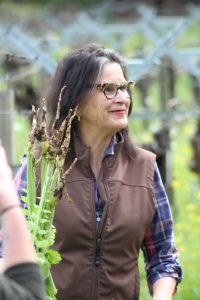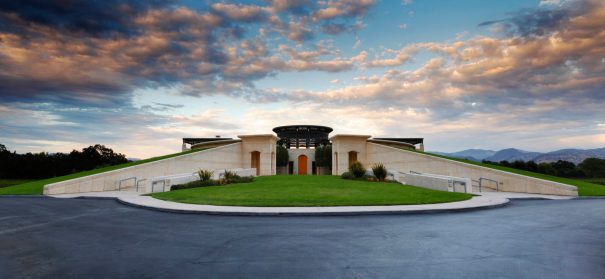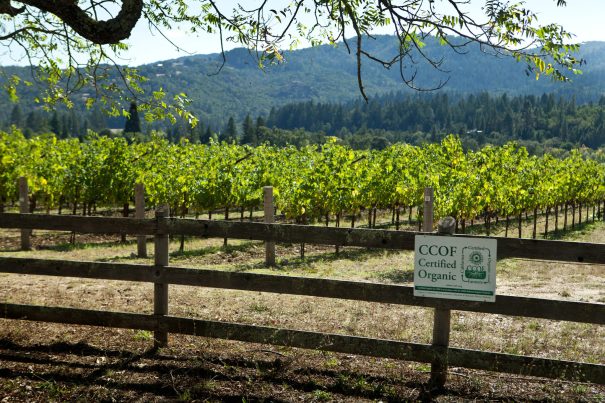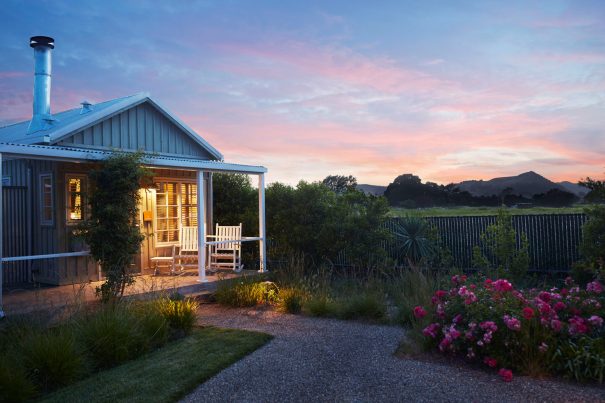The Ethical Cellar Goes To Napa
Deborah Grayson and Jonathan Russo went to Napa to learn how some of the world’s most remarkable organic wineries are finding creative ways to grow sustainably.
The 30-mile long Napa Valley has a central place in the hearts of modern American food and wine lovers. Starting in the 1860s, Italian vignerons planted vines in the diverse soil. A hundred years later, culinary revolutionary Alice Waters of Chez Panisse fame used the valley as her personal larder. Before her, legendary culinary writer M.F.K. Fisher called Napa home.
How is this famous wine destination faring in the world of heightened environmental consciousness? What are its practices regarding cultivation, processing, waste disposal, water and energy? What about the workers? Is Napa on the right carbon footprint track?
Worth recently went to find out.
All successful movements need at least one tireless promotor of the cause. Napa has this in Anna Brittain, executive director of Napa Green, a nonprofit organization worried about everything from water and energy usage to pesticides, herbicides and fungicides to social equity. To become a member of Napa Green, wineries must do much more than farm organically.
Napa Green assists wineries in their sustainable journey. For example, St. Supéry Estate Vineyards and Winery suspected they were using too much water; so, Napa Green suggested they meter their usage. It turned out that barrel washing was consuming half. The vineyard bought power hoses. Problem solved.
Over lunch Brittain explained, “We recently issued more stringent guidelines for membership. Many of our 647 partners won’t qualify unless they’re willing to make substantial changes.”
This won’t be a problem for Julie Johnson (pictured left), the grand doyenne of the ethical movement, who started Frog’s Leap, the first certified organic vineyard in Napa, with her ex-husband. Standing with her overlooking the oldest organic vines in Napa on what is now part of Tres Sabores, the winery she went on to found in 2000, Johnson’s ideas of sustainability were all around us: the vines nestled in an inches-deep carpet of nutritional cover crops recently managed with their new crimping machine; bluebird houses in abundance; and, as she and her son Rory (winemaker at Frog’s Leap) spoke passionately about risk management, a flock of sheep munched their way past us. Dry-farmed, Johnson’s soaked-in-terroir Rutherford Estate Zinfandel and Cabernet Sauvignons are outstanding.
World-renowned, with 60 percent exported, Opus One’s winery is a complete departure from Tres Sabores’ rustic pomegranate tree-lined fields. Housed in an impressive stone and glass architectural monument, for many, Opus One represents the pinnacle of Napa wines. But, as was explained to us by their decades-long winemaker Michael Silacci, the Opus One story has always been one of deep concern for the earth. They are certified organic and took an 11-year foray into biodynamics. Opus One empower workers, hand harvests, uses cultivated yeasts from their own fields and is working on a carbon recapture plan. Silacci views himself as a steward of the 170 acres and has a zen-like quest for balance. “Until we all wake up in the middle of the night worrying about the planet, nothing will change,” he said.
Opus One is one of Napa Green’s most ardent supporters and receives their highest ratings.
One mile north on the St. Helena Highway, St. Supéry’s winemaker Brooke Shenk enumerated their green efforts: “We re-use all water ending up on our floors, filter with diatomaceous earth previously sent to the landfill, generate 100 percent of our electricity needs with solar panels, have motion-activated LED lights, 100 bluebird and 10 owl boxes, ‘mow’ our fields with sheep, collect water in seven reservoirs and use biochar (burned vines) to hold moisture in our soil.” Napa Green guided them through these initiatives, and St. Supéry proudly displays their logo on each wine bottle. Fortunately, these efforts have the complete support of St. Supéry’s owner, fashion house Chanel.
Everything from their Sauvignon Blanc to their Cabernet Sauvignon have very high James Suckling ratings.
First planted in 1882 by viniculture pioneers, Spottswoode Estate Winery bought the land in 1972 and was one of the first vineyards to be certified organic in 1992. Today, they’ve gone one step beyond and are also Demeter certified Biodynamic. According to educational winemaker Molly Sheppard, the woman-owned winery’s CEO Beth Novak Milliken is “manic in her pursuit of changing for the better.” In the fields, they are ahead of Napa Green’s guidelines, so they can focus on providing their employees with full benefits. Some might say this good karma has been repaid as The Wine Advocate has awarded their red wine 100 points and Suckling has consistently scored them in the high 90s.
One of the founders of Cade Winery was California’s current governor, Gavin Newsom. Cade is unusual in Napa. At 1,700 feet, it’s high above the fog line. Their buildings are all Gold Leed Certified. (They missed Platinum status as they are too far from public transportation.) Along with working only when natural light is available through their many windows, the walls are insulated with recycled denim jeans. During our tour with winemaker Danielle Cyrot, we were awed by the unique caves buried in the hillside. Instead of a rectangular room, the architect created labyrinthine, curved tunnels of smooth concrete (high fly ash content), with ends that disappear from sight. We expected 007 in hot pursuit of a Spectre agent to thunder past from around a bend. Surprisingly, like many of their Napa compatriots, Cade does not tout their organic credentials on their bottles, primarily because pre-pandemic, 80 percent of their wines were sold to restaurants.
A nearby mountain winery is Adamvs, which Denise and Stephen Adams founded in 2008 after successfully transforming a moribund St. Emilion winery into a Grand-Cru biodynamic business. And they’re doing the same here. Now certified biodynamic, the vineyard is a series of small plots, nestled between swaths of forest. A truly pastoral farm, two donkeys guard manure-producing chickens. The result? Wine so coveted that their 2,000 cases are sold only to members and high-end restaurants, like Per Se and Jean-George.
Resorts
In Napa, you can sleep green, too. Two luxurious options are Carneros Resort and Spa in Napa and Bardessono Hotel and Spa in Yountville.
Carneros is a member of Preferred Hotel’s Beyond Green, which requires environmental and socially responsible practices. Spread over 28 bucolic acres and abutting open fields with grazing cows, many of Carneros’ individual cottages have sweeping views. Their restaurant Farm is run by Napa native executive chef Jeffrey Jake, who grows many of the restaurant’s fruits and vegetables on site. Artfully presented dishes highlight local ingredients coaxed to the most sophisticated level (try the duck). The wine list is focused on local and sustainable selections. Two notable choices are Littorai’s Pinot Noir and a rich Zinfandel from Brown’s, a minority-owned local vineyard.
Perfectly located in the heart of the Napa Valley, a block from the iconic French Laundry, lies Platinum Leed Certified Bardessono. With 82 geothermal wells, solar energy and reclaimed building materials (like tufa stone from old wine cellars), this is a minimalistic architectural oasis in an area where the “farmhouse” look predominates. Bardessono’s Lucy Restaurant and Bar creatively uses the hotel’s and locally sourced organic and biodynamic products. The miso soup (almost a full meal) and buckwheat pappardelle with rabbit sausage are uniquely delicious standouts in Napa cuisine.
Restaurants
Two very different dining choices, both promoting ethical wines, are Press and Brix.
Press provides an elegant experience in a triple-height ceilinged, fireplace-dominated room. Sample dishes you’ve probably never encountered, like octopus with mole and truffles. Other appetizers include tuna tartare with fennel flowers, trout collar with miso, smoked sea scallops with shinko pear and a memorable ricotta gnudi with matsutake whey and mushroom essence. Among the wines on their outstanding list is a Rudd Cabernet Sauvignon worth savoring.
For a casual meal and a menu with something for everyone, try Brix. While we were toasting our last night in Napa, local royalty, the Mondavi family, were at a nearby table celebrating a birthday. Menu staples, like mac and cheese and burgers, are situated side-by-side with forest mushroom risotto and caramelized sea scallops. Merry Edwards’ vibrant organic Pinot Noir pairs with a range of menu choices.
Summing Up: The last words go to Linsey Gallagher, president and CEO of Visit Napa Valley: “The issue around climate change is very real here, especially in the last three years. The wildfires had a profound impact; people are taking healing the earth seriously by putting time into creating sustainable practices. I’m seeing real passion.”
Making the commitment to third party certification takes time and effort, but it is worth it to demonstrate our commitment to the community and to protect our watershed, our land and the air we breathe.
- Susan Boswell, Chateau Boswell Winery





